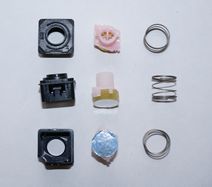Foam and foil
| This article requires illustration in the form of diagrams |
| This article requires additional photographic illustration — need more complete set of images illustrating the overall design |
This article is a stub. You can help Deskthority by expanding it.
Foam and foil refers to a design of capacitive keyswitch that uses foil discs affixed to foam pads as capacitor plates.
Design
Capacitive switches require three capacitor plates. Two are placed side by side on the PCB. The third is a movable part, whose proximity to the PCB alters the capacitance of the switch and permits detection of keypresses. In foam and foil switches, this third plate takes the form of a disc of metal foil attached to the slider. To allow for overtravel, a thick foam pad is placed between the slider and the foil disc, giving the switch its moniker.
Foam and foil switches were referred to by both Key Tronic and Cherry as "solid state". This is an inaccurate approach used to describe the fact that such switches do not use metal switch contacts, relying instead on electronic sensing; they do of course have moving parts.
Foam and foil switches have no capacity for an internal return spring, so this must be fitted to the outside of the switch. A buckling rubber sleeve can be used instead, to provide a tactile response.
Longevity
The foam pads degrade with time, and ultimately require replacement.[1]
Implementations
Several companies have manufactured foam and foil switches, with those from Key Tronic and BTC being the most prominent.
Gallery
Key Tronic foam and foil sliders and guide shafts (tactile verion)
Linear BTC foam and foil switches
Alphameric foam and foil parts
References
- ↑ OneTrueKeyboard — Keyboard on the Apple Lisa



